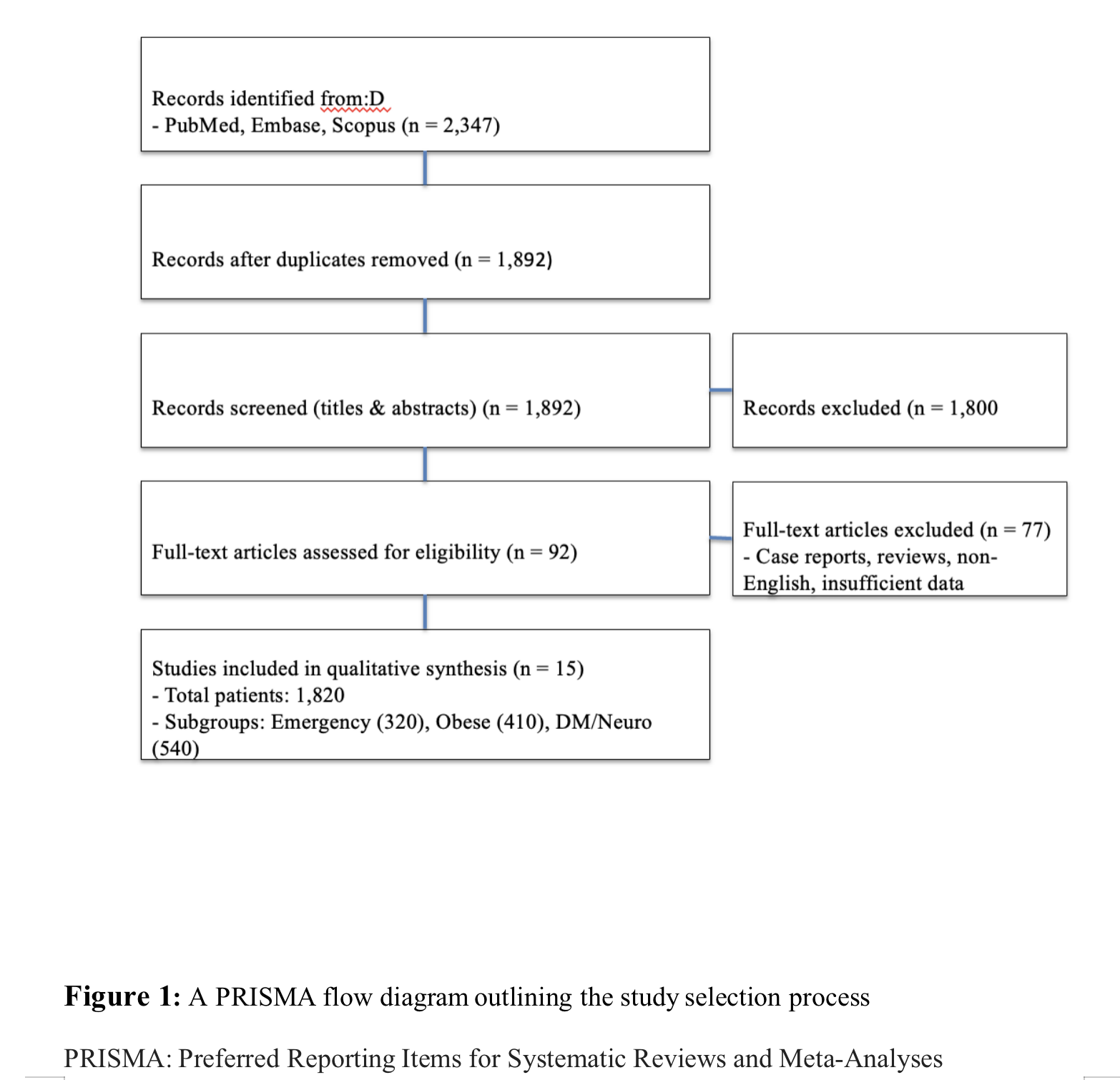Monday Poster Session
Category: General Endoscopy
P2980 - Gastric Point-of-Care Ultrasound (POCUS) for Aspiration Risk Assessment Prior to Endoscopy: A Systematic Review
Monday, October 27, 2025
10:30 AM - 4:00 PM PDT
Location: Exhibit Hall

Adithya Andanappa, MBBS
Mysore Medical College and Research Institute
Mysore, Karnataka, India
Presenting Author(s)
Adithya Andanappa, MBBS1, Hanisha Kukunoor, MBBS2, Suma Harsha Kosuru, MBBS3, Deepika Sanapala, MBBS4
1Mysore Medical College and Research Institute, Mysore, Karnataka, India; 2Maheshwara medical college and hospital, Suryapet, Telangana, India; 3Osmania General Hospital and Medical College, Aldie, VA; 4Katuri medical college, Gudivada, Andhra Pradesh, India
Introduction: Even though aspiration during upper GI endoscopy is uncommon (4.61 per 10,000 procedures), it can cause major problems, particularly for high-risk patients. Particularly at risk are stroke patients (up to 80%), diabetics with delayed gastric emptying (40–60%), and the elderly (0.1%–1.4% aspiration rates). In these populations, aspiration pneumonia raises mortality, hospital stays, and intensive care unit admissions. A quick and non-invasive way to evaluate stomach contents and possibly lower the risk of aspiration is gastric point-of-care ultrasound (POCUS). Its clinical usefulness and effect on endoscopy results, however, are still poorly understood.
Methods: A thorough search of PubMed, Embase, and Scopus was conducted to find studies evaluating gastric POCUS in adults (≥18 years) undergoing endoscopic procedures that were published up until April 2025. A total of 2,347 articles were identified, with 1,892 remaining after deduplication. Studies that reported procedural outcomes, aspiration events, or diagnostic accuracy were included in the inclusion criteria. Following title/abstract screening and full-text review, 15 studies involving 1,820 patients met the inclusion criteria. After qualitative data extraction and synthesis, a systematic review of related studies was carried out.
Results: Gastric POCUS has a sensitivity of 88–96% and specificity of 82–91% for detecting gastric content predictive of aspiration risk, according to an analysis of 15 studies (n=1,820 patients). When compared to standard risk assessment, POCUS-guided protocols were linked to a 25–35% decrease in aspiration events. POCUS increased procedural safety in high-risk cohorts (n=540) without causing appreciable delays. The standardized scanning methods performed better, while the main drawbacks were found to be operator training and protocol variability.
Discussion: The study aims to assess the clinical usefulness and diagnostic efficacy of gastric POCUS in determining aspiration risk before endoscopy. Gastric POCUS demonstrates promising diagnostic accuracy for assessing aspiration risk before endoscopy. Especially in high-risk groups, it greatly lowers aspiration events without postponing treatments. While operator dependence is still a drawback, standardized scanning methods will improve dependability. The data supports its possible clinical value despite some variation. More extensive validation is definitely needed to direct implementation.

Figure: A PRISMA flow diagram outlining the study selection process.
Disclosures:
Adithya Andanappa indicated no relevant financial relationships.
Hanisha Kukunoor indicated no relevant financial relationships.
Suma Harsha Kosuru indicated no relevant financial relationships.
Deepika Sanapala indicated no relevant financial relationships.
Adithya Andanappa, MBBS1, Hanisha Kukunoor, MBBS2, Suma Harsha Kosuru, MBBS3, Deepika Sanapala, MBBS4. P2980 - Gastric Point-of-Care Ultrasound (POCUS) for Aspiration Risk Assessment Prior to Endoscopy: A Systematic Review, ACG 2025 Annual Scientific Meeting Abstracts. Phoenix, AZ: American College of Gastroenterology.
1Mysore Medical College and Research Institute, Mysore, Karnataka, India; 2Maheshwara medical college and hospital, Suryapet, Telangana, India; 3Osmania General Hospital and Medical College, Aldie, VA; 4Katuri medical college, Gudivada, Andhra Pradesh, India
Introduction: Even though aspiration during upper GI endoscopy is uncommon (4.61 per 10,000 procedures), it can cause major problems, particularly for high-risk patients. Particularly at risk are stroke patients (up to 80%), diabetics with delayed gastric emptying (40–60%), and the elderly (0.1%–1.4% aspiration rates). In these populations, aspiration pneumonia raises mortality, hospital stays, and intensive care unit admissions. A quick and non-invasive way to evaluate stomach contents and possibly lower the risk of aspiration is gastric point-of-care ultrasound (POCUS). Its clinical usefulness and effect on endoscopy results, however, are still poorly understood.
Methods: A thorough search of PubMed, Embase, and Scopus was conducted to find studies evaluating gastric POCUS in adults (≥18 years) undergoing endoscopic procedures that were published up until April 2025. A total of 2,347 articles were identified, with 1,892 remaining after deduplication. Studies that reported procedural outcomes, aspiration events, or diagnostic accuracy were included in the inclusion criteria. Following title/abstract screening and full-text review, 15 studies involving 1,820 patients met the inclusion criteria. After qualitative data extraction and synthesis, a systematic review of related studies was carried out.
Results: Gastric POCUS has a sensitivity of 88–96% and specificity of 82–91% for detecting gastric content predictive of aspiration risk, according to an analysis of 15 studies (n=1,820 patients). When compared to standard risk assessment, POCUS-guided protocols were linked to a 25–35% decrease in aspiration events. POCUS increased procedural safety in high-risk cohorts (n=540) without causing appreciable delays. The standardized scanning methods performed better, while the main drawbacks were found to be operator training and protocol variability.
Discussion: The study aims to assess the clinical usefulness and diagnostic efficacy of gastric POCUS in determining aspiration risk before endoscopy. Gastric POCUS demonstrates promising diagnostic accuracy for assessing aspiration risk before endoscopy. Especially in high-risk groups, it greatly lowers aspiration events without postponing treatments. While operator dependence is still a drawback, standardized scanning methods will improve dependability. The data supports its possible clinical value despite some variation. More extensive validation is definitely needed to direct implementation.

Figure: A PRISMA flow diagram outlining the study selection process.
Disclosures:
Adithya Andanappa indicated no relevant financial relationships.
Hanisha Kukunoor indicated no relevant financial relationships.
Suma Harsha Kosuru indicated no relevant financial relationships.
Deepika Sanapala indicated no relevant financial relationships.
Adithya Andanappa, MBBS1, Hanisha Kukunoor, MBBS2, Suma Harsha Kosuru, MBBS3, Deepika Sanapala, MBBS4. P2980 - Gastric Point-of-Care Ultrasound (POCUS) for Aspiration Risk Assessment Prior to Endoscopy: A Systematic Review, ACG 2025 Annual Scientific Meeting Abstracts. Phoenix, AZ: American College of Gastroenterology.
